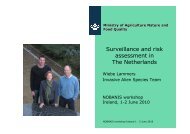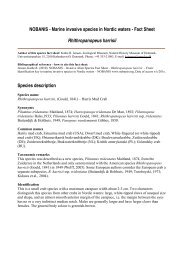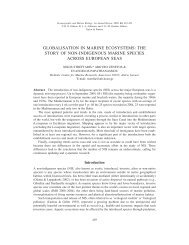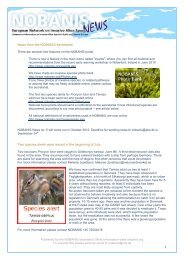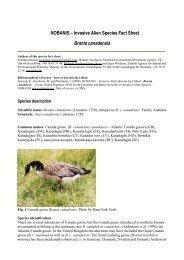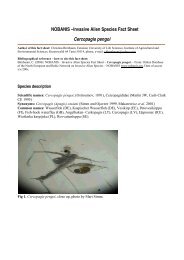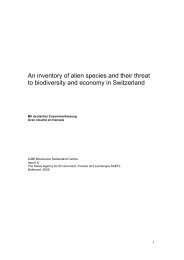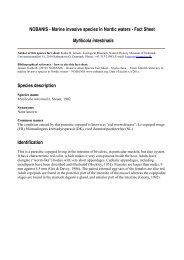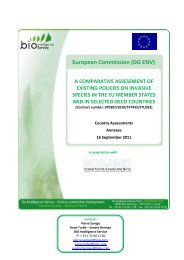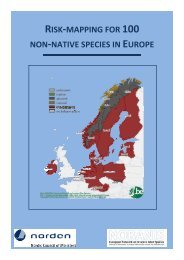Lepomis gibbosus - NOBANIS
Lepomis gibbosus - NOBANIS
Lepomis gibbosus - NOBANIS
Create successful ePaper yourself
Turn your PDF publications into a flip-book with our unique Google optimized e-Paper software.
<strong>NOBANIS</strong> – Invasive Alien Species Fact Sheet<br />
<strong>Lepomis</strong> <strong>gibbosus</strong><br />
Authors of this fact sheet: Mirosław Przybylski, Grzegorz Zięba, Department of Ecology and Vertebrate<br />
Zoology, University of Lodz, 12/16 Banacha Str., 90-237 Łódź, Poland; +48426354433,<br />
E-mail:(M. Przybylski) mprzybyl@biol.uni.lodz.pl; (G. Zięba) fringill@biol.uni.lodz.pl<br />
Bibliographical reference – how to cite this fact sheet:<br />
Przybylski, M., Zięba G. (2011): <strong>NOBANIS</strong> – Invasive Alien Species Fact Sheet – <strong>Lepomis</strong> <strong>gibbosus</strong>. – From:<br />
Online Database of the European Network on Invasive Alien Species – <strong>NOBANIS</strong> www.nobanis.org, Date of<br />
access x/x/201x.<br />
Species description<br />
Scientific names: <strong>Lepomis</strong> <strong>gibbosus</strong> (Linnaeus,1758) - Perciformes, Centrarchidae.<br />
Synonyms: Perca gibbosa Linnaeus, 1758; Pomotis vulgaris Cuvier, 1829; Pomotis auritius<br />
Günther, 1859; Eupomotis aureus Boulenger, 1895; Lepomus <strong>gibbosus</strong> Cox, 1896; Eupomotis<br />
<strong>gibbosus</strong> Jordan et Evermann, 1896.<br />
Common names: pumpkinseed, common sunfish, Sun bass(GB), slunečnice pestrá (CZ),<br />
Gemeiner Sonnenbarsch, Sonnenfisch, Kürbiskernbarsch (DE), solaborre (DK), harilik<br />
päikeseahven (EE), aurinkoahven (FI), Solabbor (NO), bass słoneczny (PL), Solechnaya ryba<br />
(RU), solabborre (SE).<br />
Fig. 1. <strong>Lepomis</strong> <strong>gibbosus</strong> from England, photo by G. H. Coop.
Fig. 2. <strong>Lepomis</strong> <strong>gibbosus</strong>, photo by S. Stakėnas.<br />
Species identification<br />
L. <strong>gibbosus</strong> has a high and laterally compressed body resembling perch. The maximum size is<br />
up to 40 cm of total length (Tl) in its native area (Page and Burr 1991), but is smaller in<br />
European water bodies (Copp et al. 2004). The mouth is small in a top position with patches<br />
of sharp hooked teeth on the jaws. There are pads of teeth on the lower pharynx. The long<br />
dorsal fin consists of two parts (broadly joined and appear as one). The anterior part is smaller<br />
than the posterior and has 9-12 spines; posterior part is higher and has 10-14 soft rays. There<br />
are 3 spines in the anal fin followed by 8-11 soft rays. Pelvic fins are located thoracically and<br />
pectoral fins have only one anterior spine. It has 28-30 vertebrae and 7-8 long pyloric caecae.<br />
The lateral line is complete, bent dorsally in the middle part of the body. It has ctenoid scales,<br />
and there are 35-47 ctenoid scales along the lateral line. The colouration is variable with the<br />
upper head and back being greenish blue or olive. On the sides, there are some isolated spots<br />
formed by some vertical bands. The belly is yellow and the gill covers opalescent blue to<br />
green with conspicuous black spot edged with red. The coloration intensifies at spawning time<br />
in both sexes (Scott and Grossman 1973, Maitland and Campbell 1992). Its karyotype is<br />
2n=48 (Roberts 1964). As the fish morphology is strongly affected by pray type, feeding<br />
mode and habitat type, the moderate variation in body shape, length of fins, pharyngeal jaw<br />
bones size and gill rakers shape (Brinsmead and Fox 2002, Gillespie and Fox 2003, Vila-<br />
Gispert et al. 2007) are common.<br />
Native range<br />
L. <strong>gibbosus</strong> is native to the temperate Eastern North America from New Brunswick (Canada)<br />
to the subtropical Florida peninsula (USA) (Scott and Grossman 1973).<br />
Alien distribution<br />
History of introduction and geographical spread<br />
In Europe the species is introduced to many regions and river systems (Welcomme 1988,<br />
Copp and Fox 2007). Today it is found in West and Central Europe (de Groot 1985,<br />
Welcomme 1988) as well as in the Iberian Peninsula (Sostoa et al. 1987) and the Black Sea<br />
region (Economidis et al. 1981). In 1877 the first specimens of L. <strong>gibbosus</strong> were introduced<br />
from Canada to France (Arnold 1990).<br />
In Germany, L. <strong>gibbosus</strong> was introduced in 1885 (or 1881 according to FAO (1997)) by Max<br />
von dem Borne, who was a pioneer of importing fish and crayfish for aquaculture (Kowarik<br />
2003, Copp et al. 2005).<br />
2
In the Czech Republic it was recorded in 1929 in the Třeboňsko region (Baruš and Olivia<br />
1995) In Poland L. <strong>gibbosus</strong> is noted only in the Oder River system (Rembiszewski and Rolik<br />
1975, Witkowski 1979, Witkowski et al. 2004). Today a sustainable population is established<br />
in the lower Oder, in a site influenced by warm water from a nearby electric power station<br />
(Hesse and Przybyszewski 1985). In Denmark the species was first reported in 2002, and the<br />
first confirmed self-reproducing population identified in 2006 (Jensen 2002). In Norway the<br />
species was reported in 2005 (Sterud and Jørgensen 2006). In Austria, the year of introduction<br />
of L. <strong>gibbosus</strong> is not known. The first documented voucher specimens are from 1952<br />
(Mikschi 2005).<br />
The purposes and histories of such introductions to other European countries are somewhat<br />
unclear. It seems that aquarists played a prominent role in the spread of L. <strong>gibbosus</strong><br />
throughout Europe (Tandon 1976). The main purpose for the deliberate introduction of L.<br />
<strong>gibbosus</strong> into English waters was as an ornamental fish (Copp et al. 2002).<br />
Pathways of introduction<br />
The species was introduced to Europe mainly by aquarists. As an ornamental fish, L. <strong>gibbosus</strong><br />
was introduced and stocked in garden ponds as well as in aquaria and released to different<br />
water bodies. Some authors also assume that L. <strong>gibbosus</strong> could be introduced unintentionally<br />
with imports of carp fry used in stocking (Tandon 1976. L. <strong>gibbosus</strong> has been intentionally<br />
(but illegally) introduced to lakes in Denmark with Onchorhynchus mykiss under the<br />
presumption that they would free the Rainbow trout from the fish louse (Argulus sp.) (Jan K.<br />
Jensen, pers. comm.).<br />
Alien status in region<br />
L. <strong>gibbosus</strong> is a one of 40 alien fish species recorded in Polish waters (www.iop.krakow.pl).<br />
This fish was not introduced intentionally and today occurs only in a few locations in the<br />
lower Oder River area. The abundant self-sustained population occurs only in the Oder R.<br />
nearby Szczecin, where water is heated by an electric plant (Terlecki 2000).<br />
In Denmark two populations are known to have been naturalised, which both are selfreproducing<br />
(Jensen 2002, Jensen et al. 2007). It is likely that there are more populations, but<br />
it is not documented. It is still unknown if the species will spread in Danish waters and<br />
develop the invasive behaviour reported from other countries (Møller et al. 2008).<br />
L. <strong>gibbosus</strong> has the reputation that it can control Argulus foliaceus which is why it has been<br />
released.<br />
L. <strong>gibbosus</strong> is widely distributed throughout German inland waters. It has established<br />
permanent populations in many ponds, lakes and rivers. This species is especially found in<br />
higher abundances in the backwaters of the upper Rhine River as well as often in park ponds<br />
of large towns (Arnold 1990, Freyhoff 2003).<br />
The northernmost reproducing population is reported from Norway (Sterud and Jørgensen<br />
2006).<br />
The species is not known from Finland, Sweden, Greenland, Faroe Islands (see also table 1).<br />
3
Country<br />
Austria<br />
Belgium<br />
Czech republic<br />
Denmark<br />
Estonia<br />
European part of Russia<br />
Finland<br />
Faroe Islands<br />
Germany<br />
Greenland<br />
Iceland<br />
Ireland<br />
Latvia<br />
Lithuania<br />
Netherlands<br />
Norway<br />
Poland<br />
Slovakia<br />
Sweden<br />
Not<br />
found<br />
X<br />
X<br />
X<br />
X<br />
X<br />
X<br />
X<br />
X<br />
Not<br />
established<br />
Rare Local Common Very<br />
common<br />
X<br />
X<br />
X<br />
X<br />
X<br />
X<br />
X<br />
X<br />
X<br />
Not<br />
known<br />
Table 1. The frequency and establishment of <strong>Lepomis</strong> <strong>gibbosus</strong>, please refer also to the<br />
information provided for this species at www.nobanis.org/search.asp. Legend for this table:<br />
Not found –The species is not found in the country; Not established - The species has not<br />
formed self-reproducing populations (but is found as a casual or incidental species); Rare -<br />
Few sites where it is found in the country; Local - Locally abundant, many individuals in<br />
some areas of the country; Common - Many sites in the country; Very common - Many sites<br />
and many individuals; Not known – No information was available.<br />
Ecology<br />
Habitat description<br />
In both its native and introduced area, L. <strong>gibbosus</strong> inhabits the shallow water in lakes and<br />
slow running rivers with soft bottoms and submerged vegetation. It can be found in ponds,<br />
where it is kept as an ornamental fish, and in side arms of large rivers or backwaters (Scott<br />
and Grossman 1973, Maitland and Campbell 1992).<br />
Reproduction and life cycle<br />
L. <strong>gibbosus</strong> is a multispawning fish with male parental care (Balon 1957). According to the<br />
style of reproduction the nest guarding sunfish is classified as a polyphil - group B.2.6 in<br />
Balon (1975) classification. Spawning begins when water temperature is high (i.e. close to<br />
20 o C), in Poland usually in June. However in different areas spawning can start in May and<br />
extend until the end of July (e.g. in Slovakia) (Baruš and Oliva 1995, Zięba et. al 2010).<br />
Territorial males defend a small territory and build a nest, a small depression (3-5 cm deep<br />
and up to 40 cm across) in the vicinity of weeds. The size of the nest is approximately twice<br />
that of a male. The courtship displayed by the couple is restricted to a sequence of twisting<br />
and repeated spawning actions in the nest occasionally interrupted by others males. One male<br />
4
can spawn consecutively with several females. After spawning, the male guards the nest while<br />
fanning eggs and guarding fry until the yolk sac absorption (Balon 1957).<br />
In the entire area of its distribution, L. <strong>gibbosus</strong> exhibits a remarkable variation in its life<br />
history traits. Usually L. <strong>gibbosus</strong> matures at age 1-2. The female’s absolute fecundity varies<br />
between 600-5000 eggs, but it changes with fish size and type of environment (Crivelli and<br />
Mestre 1988, Fox and Crivelli 2001, Copp et al. 2002). Eggs are yellow with a large amount<br />
of yolk and 1 mm in diameter (range 0.8-1.3 mm). This species can live up to 10 years (native<br />
range), but in Europe the maximum life span is 8 years (Copp et al. 2004). There are no<br />
published studies of L. <strong>gibbosus</strong> reproduction in Polish waters (Terlecki 2000).<br />
The variation in growth, summarised by Copp et al. (2004), Copp and Fox (2007) and<br />
updated for northwestern Europe populations by Cucherousset et al. 2009, shows distinct<br />
differences between North American and European populations. In Europe, the mean body<br />
size and adult growth rates are smaller than in North America. Also the average asymptotic<br />
length is higher for American populations than European ones.<br />
In general L. <strong>gibbosus</strong> is an omnivorous fish, feeding mainly on worms, crustacean and<br />
insects but consuming also small fishes and fish eggs as well as other vertebrates (FishBase).<br />
Godinho et al. (1997) and Zapata and Granado-Lorencio (1993) found that L. <strong>gibbosus</strong> feed<br />
mainly the most abundant prey types but juveniles and adults commonly use different food<br />
resources (ontogenetic diet shift).<br />
Dispersal and spread<br />
The rate of expansion of L. <strong>gibbosus</strong> in Polish waters is very low probably due to the high<br />
temperature required by the species. Today this species occurs only in a few sites in the lower<br />
River Oder drainage and it is absent in some sites where it was noted previously (Terlecki<br />
2000).<br />
Impact<br />
Affected habitats and indigenous organisms<br />
Although there is a lack of information on the impact of L. <strong>gibbosus</strong> on the habitat and native<br />
fish species (Witkowski 1989, 1996, 2002), L. <strong>gibbosus</strong> may have adverse ecological impacts<br />
in the area of its introduction (FishBase), such as competition with other species. For<br />
example, in Mediterranean reservoirs and a Danish lake L. <strong>gibbosus</strong> has been observed to<br />
reduce the abundance of larger forms of zooplankton, which may lead to an increase of<br />
eutrophication effects (Brabrand and Saltveit 1989, Jan K. Jensen, pers. comm.). The high diet<br />
overlap found between native (gudgeon, roach) and non-native (e.g. pumpkinseed) fish in<br />
ponds in the De Maten (Belgium) nature reserve (Declerck et al. 2002) may also indicate high<br />
potential for interspecific exploitative competition. Furthermore, the species has been found to<br />
be heavily infected (intensity < 100) with non-native monogenean parasites (Sterud and<br />
Jørgensen 2006). The identity of these is not yet fully resolved, and the possible impact on<br />
native fish communities is thus not clear.<br />
Genetic effects<br />
No genetic defects have been reported, but L. <strong>gibbosus</strong> will hybridise with most other<br />
<strong>Lepomis</strong>, especially with L. cyanellus, which is also introduced in some European countries.<br />
The result is usually fast-growing, sterile male hybrids (Moyle 1976 cited in Fuller et al.<br />
1999).<br />
5
Human health effects<br />
No human health effects have been reported.<br />
Economic and societal effects (positive/negative)<br />
Due to its low abundance and narrow distribution L. <strong>gibbosus</strong> has not been observed to<br />
produce significant effects.<br />
Management approaches<br />
Prevention methods<br />
Introduction of alien fish into open waters is prohibited in most European countries (Copp et<br />
al. 2005). Due to the fact that L. <strong>gibbosus</strong> is spread mainly by aquarists and owing to its<br />
temperature preferences L. <strong>gibbosus</strong> populations could easily be kept under control. However,<br />
increasing water temperatures may favour L. <strong>gibbosus</strong> and change the situation in the future<br />
(Zięba et al. 2010). In favourable habitats (i.e. heated water), L. <strong>gibbosus</strong> may become very<br />
abundant and perhaps impossible to eliminate. It seems that the main preventive method<br />
should be shifting interest of aquarists to keep native fish in garden ponds instead of<br />
ornamental species such as L. <strong>gibbosus</strong>. Additionally, it is important to inform that it is<br />
forbidden to release aquarium fish into open waters.<br />
Eradication, control and monitoring efforts<br />
In general, no eradication project should begin unless a specific assessment study has shown<br />
its technical and financial feasibility. The main constraint is the lack of species-specific<br />
eradication techniques to be applied to fish (Scalera and Zaghi 2004). In Germany, for<br />
example, there is no coordinated monitoring programme to document the spreading and<br />
impacts of L. <strong>gibbosus</strong>. Thus, it is still a challenge to act on this alien species. Therefore,<br />
existing management initiatives and instruments as well as the implementation of new and<br />
relevant projects, must be carefully applied (Nehring and Klingenstein 2005).<br />
Information and awareness<br />
There are no reports of information or awareness campaigns regarding the species.<br />
Knowledge and research<br />
Further, detailed studies on the biology and especially the effect of the species on the native<br />
biota are necessary.<br />
Recommendation or comments from experts and local communities:<br />
None<br />
References and other resources:<br />
Contact persons<br />
Wolfgang Rabitsch (AT), Umweltbundesamt, Naturschutz, Spittelauer Lände 5, 1090 Wien,<br />
Austria, Phone: +43- (0) 1-313 04/3340, E-mail: wolfgang.rabitsch@umweltbundesamt.at<br />
Hugo.Verreycken (BE), E-mail: Hugo.Verreycken@inbo.be<br />
6
Radek Šanda (CZ), Department of Zoology, National museum, Václavské náměstí 68, 115 79<br />
Praha 1, CZECH REPUBLIC, E-mail: radek_sanda@nm.cz<br />
Stefan Nehring (DE), AeT umweltplanung, Bismarckstraße 19, D-56068 Koblenz, Germany<br />
Phone: +49 261 1330398; E-mail: nehring@aet-umweltplanung.de<br />
Jan Kjærgaard Jensen (DK), Danish Ministry of the Environment, Forest and Nature<br />
Agency,DK-8600 Silkeborg, Denmark, E-mail: jkj@sns.dk<br />
Lauri Urho (FI), Finnish Game and Fisheries Research Institute (RKTL), Viikinkaari 4, P.O.<br />
Box 2 FI-00791 Helsinki, Finland, Phone +358 20 575 11, E-mail: lauri.urho@rktl.fi<br />
Colette O'Flynn (IE), National Biodiversity Data Centre, WIT West campus, Carriganore,<br />
Waterford, Ireland, Phone: +353 (0) 51306240, E-mail: coflynn@biodiversityireland.ie<br />
Gudni Gudbergsson (IS), Institute of Freshwater Fisheries, Keldnaholti, 112 Reykjavik,<br />
Iceland. Tel: +354 5806300. Fax: +354 5806301, E-mail: HYPERLINK<br />
"mailto:gudni.gudbergsson@veidimal.is" gudni.gudbergsson@veidimal.is<br />
Saulius Stakėnas (LT), Institute of Ecology of Vilnius University, Lithuania, E-mail:<br />
saulius.stakenas@gmail.com<br />
Yury Dgebuadze (RU), Severtsov Institute of Ecology and Evolution, Russian Academy of<br />
Sciences, Leninsky prospekt, 33, Moscow, 119071, Russia, e-mail: dgebuadze@sevin.ru<br />
Susanna Pakkasmaa (SE), Swedish National Board of Fisheries Institute of Freshwater<br />
Research Stångholmsvägen, SE-178 93 Drottningholm, Sweden, Tel: 08-699 06 34. E-mail:<br />
Susanna.Pakkasmaa@fiskeriverket.se<br />
Vladimír Kováč (SK), Comenius University, 842 15 Bratislava 4, Mlynská dolina, Slovakia,<br />
Phone: +421 (02) 60296 422, E-mail: kovac@fns.uniba.sk<br />
Gordon H. Copp (UK), Cefas, Salmon & Freshwater Team, Pakefield Road, Lowestoft,<br />
Suffolk, NR33 0HT, United Kingdom, Phone: 01502 527751, E-mail:<br />
gordon.copp@cefas.co.uk<br />
Links<br />
www.fishbase.org<br />
Aquatic alien species in German inland and coastal waters - database<br />
www.iop.krakow.pl<br />
Alien species in Poland – database of the Institute of Nature Conservation<br />
Polish Academy of Sciences [in English] last access 14/05/2010<br />
References<br />
Arnold A. 1990. Eingebürgerte Fischarten. Die Neue Brehm-Bücherei Band 602: 144 pp.<br />
Balon E. K. 1957. Nerest <strong>Lepomis</strong> <strong>gibbosus</strong> (Linné, 1758), aklimatizovanej v bočných vodach Dunaja a jej vývoj<br />
počas embryonalnej periody. Vĕst. Čs. spol. zool., 23: 1-22.<br />
Balon E. K. 1975. Reproductive guids of fishes: a proposal and definition. J. Fish Res. Can., 32:821-864.<br />
Baruš V. and Oliva O. 1995. Fauna of the Czech and Slovak Republics. Volume 28/2. Fishes - Osteichthyes.<br />
Academia, Praha. (in Czech with English summary).<br />
Brabrand Å. and Saltveit S.J. 1989. Ecological aspects of the fish fauna in three Portuguese reservoirs. Arch.<br />
Hydrobiol. 114: 575-589.<br />
7
Brinsmead J. and Fox M.G. 2002. Morphological variation between lake-and streamdwelling rock bass and<br />
pumpkinseed populations. J. Fish Biol. 61: 1619-1638.<br />
Copp G.H., Fox M.G. 2007. Growth and life history traits of introduced pumpkinseed (<strong>Lepomis</strong> <strong>gibbosus</strong>) in<br />
Europe, and the relevance to its potential invasiveness. in: Gherardi F. (ed.) Biological invaders in inland<br />
waters: Profiles, distributions, and threats. British Crown, 289-306.<br />
Copp G.H., Fox M.G. and Kováč V. 2002. Growth, morphology and life history traits of a coolwater European<br />
population of pumpkinseed <strong>Lepomis</strong> <strong>gibbosus</strong>. Archiv Hydrobiol., 155: 585-614.<br />
Copp G. H., Fox M. G., Przybylski M., Godhinho F. N. and Vila-Gispert A. 2004. Life-time growth pattern of<br />
pumpkinseed <strong>Lepomis</strong> <strong>gibbosus</strong> introduced to Europe, relative to native North American populations. Folia<br />
Zool., 56: 237-254.<br />
Copp G. H., Bianco P. G., Bogutskaya N. G., Eros T., Falka I., Ferreira M. T., Fox M. G., Freyhof J., Gozlan R.<br />
E., Grabowska J., Kováč V., Moreno-Amich R., Naseka A. M., Peňáz M., Povz M., Przybylski M., Robillard<br />
M., Russell I. C., Stakenas S., Šumer S., Vila-Gispert A. and Wiesner C. 2005. To be, or not to be, a nonnative<br />
freshwater fish? J. Appl. Ichthyol. 21: 242–262.<br />
Crivelli A.J. and Mestre D. 1988: Life history traits of pumpkinseed <strong>Lepomis</strong> <strong>gibbosus</strong> introduced into the<br />
Camargue, a Mediterranean wetland. Arch. Hydrobiol. 111: 449-466.<br />
Cucherousset J., Copp G.H., Fox M.G., Sterud E., van Kleef H.H., Verreycken H. and Záhorská E. 2009. Lifehistory<br />
traits and potential invasiveness of introduced pumpkinseed <strong>Lepomis</strong> <strong>gibbosus</strong> populations in<br />
northwestern Europe. Biol. Invasions. 11: 2171-2180.<br />
Declerck S., Louette G., De Bie T. and De Meester L. 2002. Pattrens of diet overlap between populations of<br />
non-indigenous and native fishes in shallow ponds. J. Fish Biol. 61: 1182-1197.<br />
Economidis P. S., Kattoulas M. and Stephanidis. E. 1981. Fish fauna of the Aliakmon Rriver and the adjacent<br />
waters (Macedonia, Greece). Cybium, 5: 89-95.<br />
FAO, 1997. FAO Database on Introduced Aquatic Species.. FAO Database on Introduced Aquatic Species, FAO,<br />
Rome<br />
Fox M. G. and Crivelli A. J. 2001. Life history traits of pumpkinseed (<strong>Lepomis</strong> <strong>gibbosus</strong>) populations introduced<br />
into warm thermal environments. Arch. Hydrobiol., 150: 561-580.<br />
Freyhof J. 2003. Immigration and potential impacts of invasive freshwater fishes in Germany. Berichte des IGB<br />
17: 51-58.<br />
Fuller P.L., Nico L.G. and Williams J.D. 1999. Nonindigenous fishes introduced into inland waters of the United<br />
States. American Fisheries Society Special Publication 27: 613 pp.<br />
Gillespie G.J. and Fox M.G. 2003. Morphological and life history differentiation between littoral and pelagic<br />
forms of pumpkinseed (<strong>Lepomis</strong> <strong>gibbosus</strong>). J. Fish Biol. 62:1099-1115.<br />
Godinho F.N., Ferreira M.T. and Cortes R.V. 1997. The environmental basis of diet variation in pumpkinseed<br />
sunfish, <strong>Lepomis</strong> <strong>gibbosus</strong>, and largemouth bass, Micropterus salmoides, along an Iberian river basin.<br />
Environ. Biol. Fish., 50: 105-115.<br />
de Groot S. J. 1985. Introduction of non-indigenous fish species for release and culture in the Netherlands.<br />
Aquaculture, 46: 237-257.<br />
Heese T. and Przybyszewski C. 1985. Pumpkinseed sunfish, <strong>Lepomis</strong> <strong>gibbosus</strong> (L., 1758), (Pisces,<br />
Centrarchidae) in the Lower Oder. Prz. zool., 29: 515-519. (in Polish with English summary)<br />
Jensen J. K. 2002: Nye dyr i Danmark.- Natur og Museum 2002 hæfte 3. 35 pp.<br />
Jensen J. K., Sivebæk F., Carl H. 2007 Solaborre (<strong>Lepomis</strong> <strong>gibbosus</strong>) etableret i det fri i Danmark. With an<br />
English summary, - - Flora og fauna 113(2): 25-29<br />
Kowarik I. 2003. Biologische Invasionen - Neophyten und Neozoen in Mitteleuropa. - Ulmer: Stuttgart, 380 pp.<br />
Maitland P. S. and Campbell R. N. 1992. Freshwater Fishes of the British Isles. Harper Colins Publishers,<br />
London<br />
Mikschi, E. 2005: Fische. Grüne Reihe des Lebensministeriums 15: 133-147.<br />
Møller, P. R., Carl, H. And Nielsen, J. G. 2008 Findes der invasive ferskvandsfisk i Danmark? Dyr i natur og<br />
museum 2008/1 (in Danish)<br />
Nehring S. and Klingenstein F. 2005. Alien species in the Wadden Sea - A challenge to act. Wadden Sea<br />
Newsletter 31: 13-16.<br />
Page L.M. and Burr B.M. 1991. A field guide to freshwater fishes of North America north of Mexico.. Houghton<br />
Mifflin Company, Boston. 432 p<br />
Rembiszewski J. M. and Rolik H. 1975. Katalog fauny Polski. Krągłouste i ryby. PWN. Warszawa. (in Polish)<br />
Roberts F. L. 1964. A chromosome study of twenty species of Centrarchidae. J. Morph., 115: 401-418.<br />
Scalera R. and Zaghi D. 2004. Alien species and nature conservation in the EU: The role of the LIFE program.<br />
European Commission, Office for Official Publications of the European Communities: 56 pp.<br />
Scott W. B. and Grossman E. J. 1973. Freshwater Fishes of Canada. Fish. Res. Bd. Canada Bull., 184: 1-966.<br />
8
Sostoa A., Lobon-Cervia J., Fernandez-Colome V. and Sostoa F. J. 1987. La distribucion del pez sol (<strong>Lepomis</strong><br />
<strong>gibbosus</strong> L.) en la Peninsula Iberica. Donana. Acta Vertebrata 14: 121-123.<br />
Sterud E. and Jørgensen A. 2006. Pumpkinseed <strong>Lepomis</strong> <strong>gibbosus</strong> (Linnaeus, 1758) (Centrarchidae) and<br />
associated parasites introduced to Norway. Aquatic invasions 1(4):278-280.<br />
Tandon K. K. 1976. Notes on systematics of the Pumpkin Seed, <strong>Lepomis</strong> <strong>gibbosus</strong> (Ostheichthyes, Perciformes,<br />
Centrarchidae). Vĕst. Čs. spol. zool., 40: 307-311.<br />
Terlecki J. 2000. Bas słoneczny. in: Brylińska M. (ed.) Ryby słodkowodne Polski. PWN, Warszawa, 453-455.<br />
[in Polish].<br />
Vila-Gispert A., Fox M.G., Zamora L. and Moreno-Amich R. 2007. Morphological variation in pumpkinseed<br />
<strong>Lepomis</strong> <strong>gibbosus</strong> introduced into Iberian lakes ans reservoirs; adaptations to habitat and diet? J. Fish Biol.<br />
71: 163-181.<br />
Welcomme R. L. 1988. International Introduction of Inland Aquatic species. FAO Tech. Pap. 294.<br />
Witkowski A. 1979. New locality of sunfish, <strong>Lepomis</strong> <strong>gibbosus</strong> (L.) (Osteichthyes: Centrarchidae) in catchment<br />
area of the Barycz River. Fragmenta Faunistica, 25: 15-19.<br />
Witkowski A. 1989. Introdukowane ryby w polskich wodach i ich wpływ na środowisko. Prz. Zool., 33: 589-<br />
598. (in Polish with English summary)<br />
Witkowski A. 1996. Introduced fish in Poland: pros and cos. Arch. Pol. Fish. 4; 101-112.<br />
Witkowski A. 2002. Introduction of fishes into Poland: benefaction or plague? Nature Conservation, 59: 41-52.<br />
Witkowski A., Kotusz J., Przybylski M., Marszał L., Heese T., Amirowicz A., Buras P. and Kukuła K. 2004.<br />
Origin, species composition and present degree of threat to fish fauna in the Vistula and Oder river systems.<br />
Arch. Pol. Fish., 12 (Supl.): 7-20.<br />
Zapata S.C. and Granado-Lorencio C. 1993: Age, growth and feeding of the exotic species <strong>Lepomis</strong> <strong>gibbosus</strong> in<br />
a Spanish cooling reservoir. Arch. Hydrobiol., 90 (Suppl.): 561-573.<br />
Zięba G., Fox M.G., Copp G.H. 2010. The effect of elevated temperature on spawning of introduced<br />
pumpkinseed <strong>Lepomis</strong> <strong>gibbosus</strong> in Europe. Journal of Fish Biology, 77, 8: 1850-1856.<br />
Date of creation/modification of this fact sheet: 09-05-2007 / 07-02-2011<br />
9



